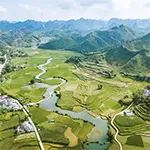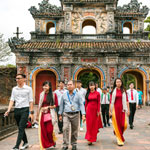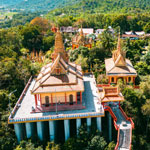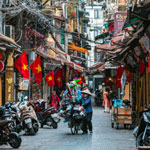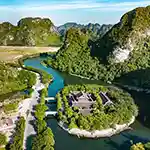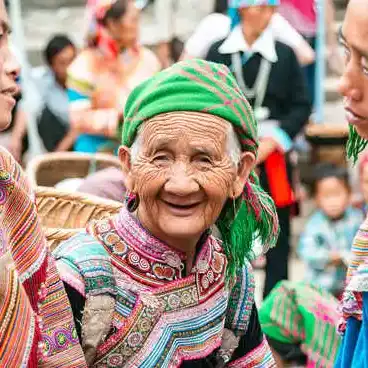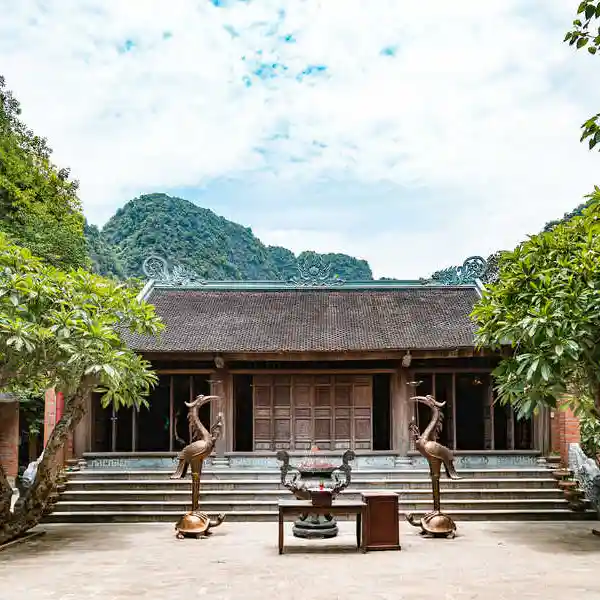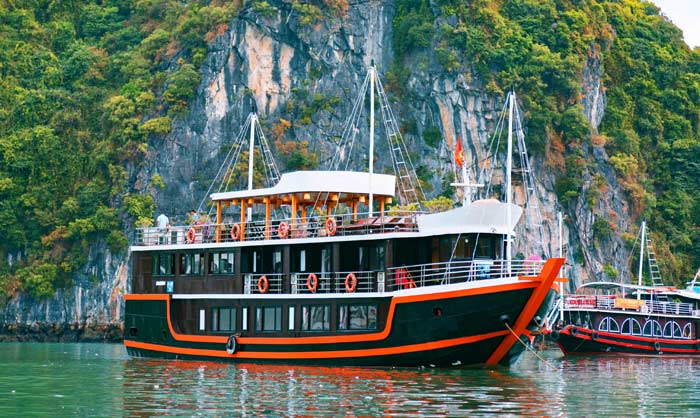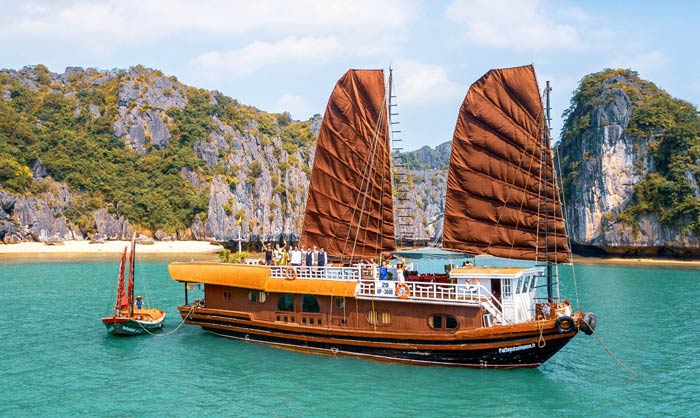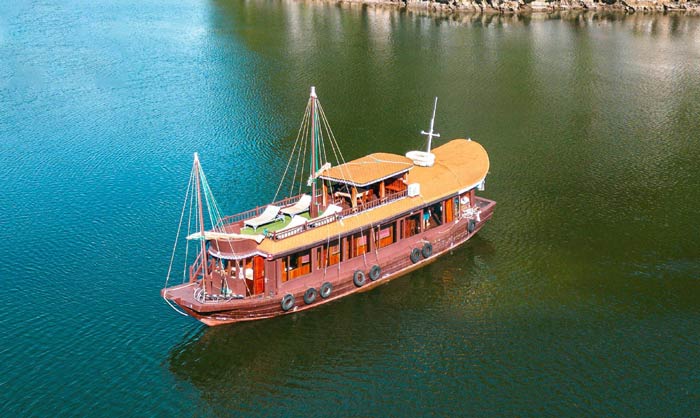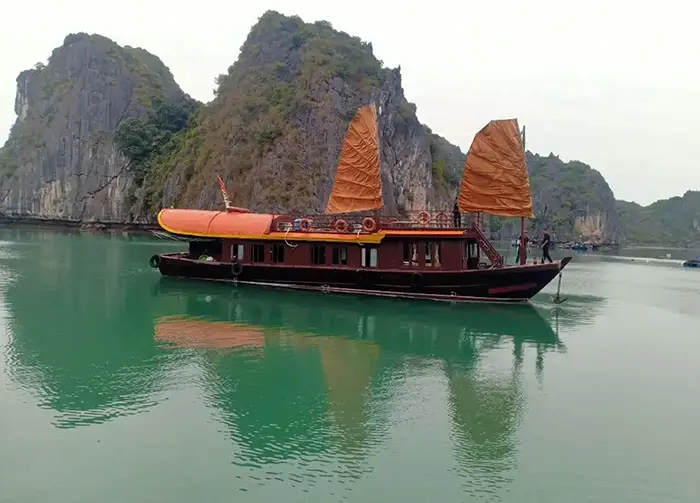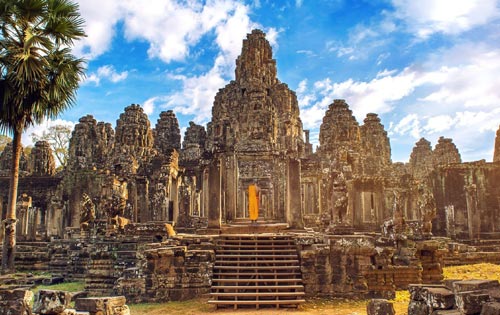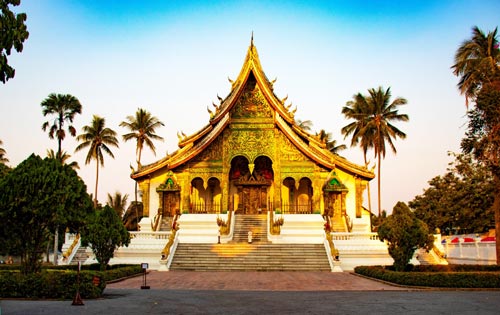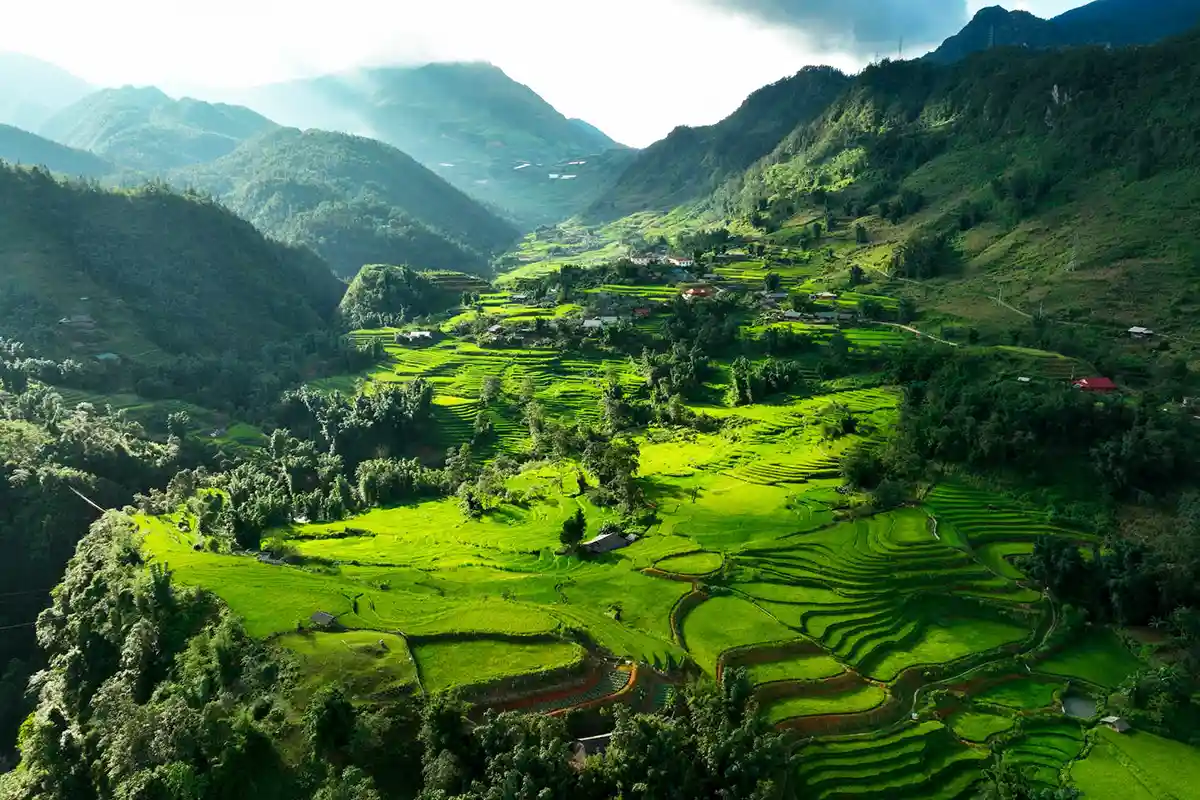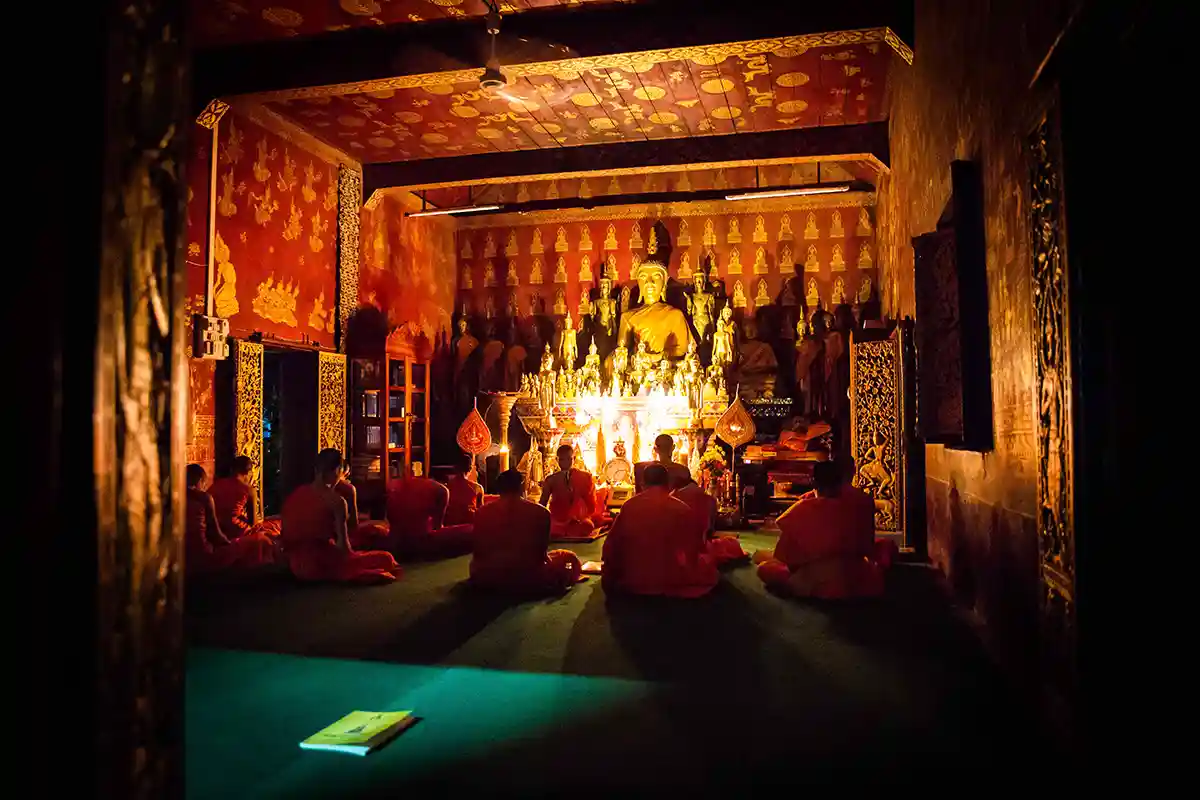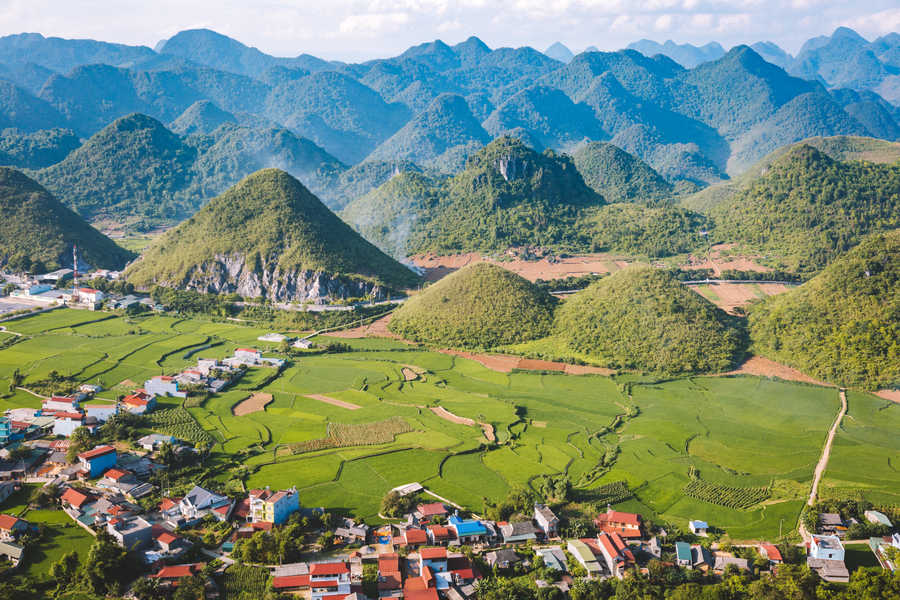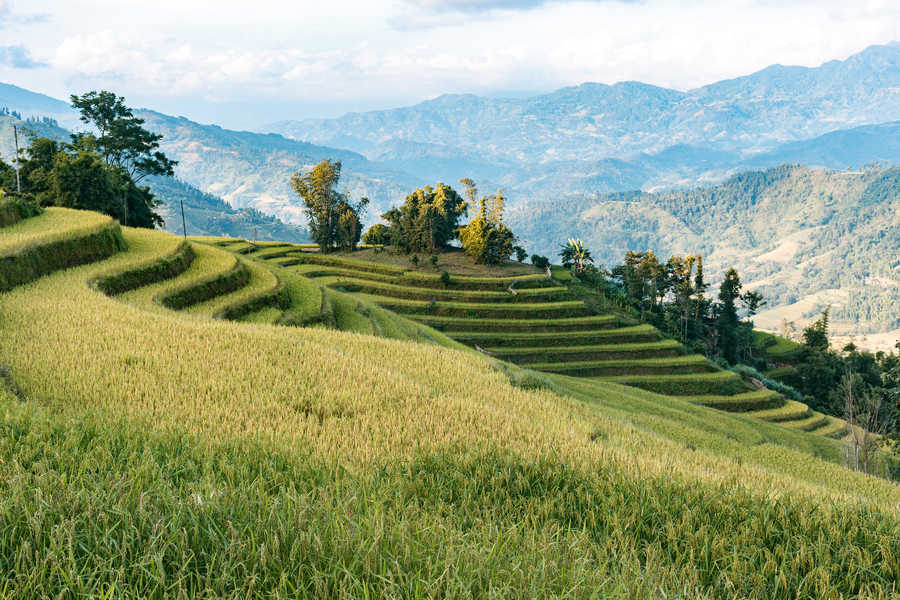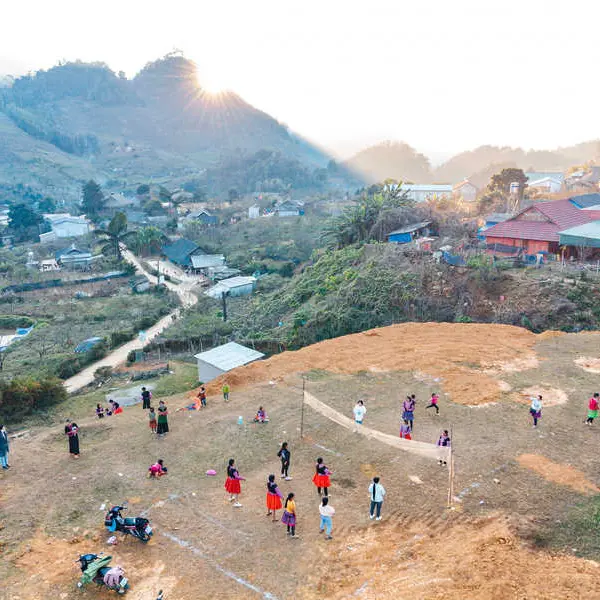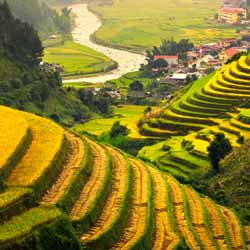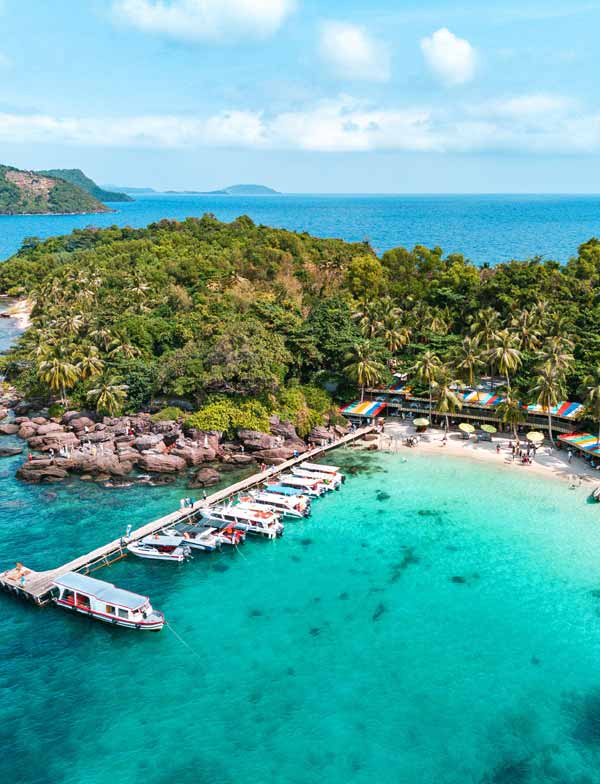・Cultural Tours in Vietnam・

Discover the history and cultures of Vietnam
Vietnam is a country rich in history, art, and culture. Discover this wealth through tours specially designed for those with a thirst for knowledge.
They are ideal not only for history and culture enthusiasts, but also for travelers who may not be particularly drawn to the beach or long hikes!
The strengths of our tours? Without a doubt, the diversity of visits: archaeological remains, architectural styles, religious sites, historical heritage, museum visits, and encounters with ethnic groups and their traditions.
All our tours are private, designed for those who want to discover Vietnam in a privileged way, guided by French-speaking experts who lovingly share the customs and traditions of their country.
Explore below our cultural travel ideas in Vietnam and contact us to customize your journey!
Our Cultural Tours in Vietnam
A comprehensive 15-day tour exploring Northern Vietnam and its spectacular landscapes: terraced rice fields, the Ha Giang loop, Halong Bay…
North Vietnam & Luang Prabang in 12 Days: Pu Luong Rice Terraces, Halong Bay, and the Temples & Spiritual Traditions of Laos
Northeast Vietnam in 8 Days: Ha Giang, Ma Pi Leng Pass, Ban Gioc Waterfalls, Ba Be Lake, and Off-the-Beaten-Path Nature Immersion
A tour to explore the natural and cultural heritage of Northern and Central Vietnam: Hanoi, Halong Bay, Ninh Binh, Phong Nha caves…
6-Day Trekking in Hoang Su Phi: Meet Ethnic Communities, Explore Terraced Rice Fields, and Experience Authentic Homestays
Embark on an 8-day immersive tour exploring Hua Tat, Pu Luong, and the two Ha Long Bays (both maritime and terrestrial).
Top Cultural Destinations in Vietnam
If you are considering a cultural tour in Vietnam, there are a few destinations you shouldn’t miss to learn about the country’s history and cultural diversity.
Northern Vietnam Mountains
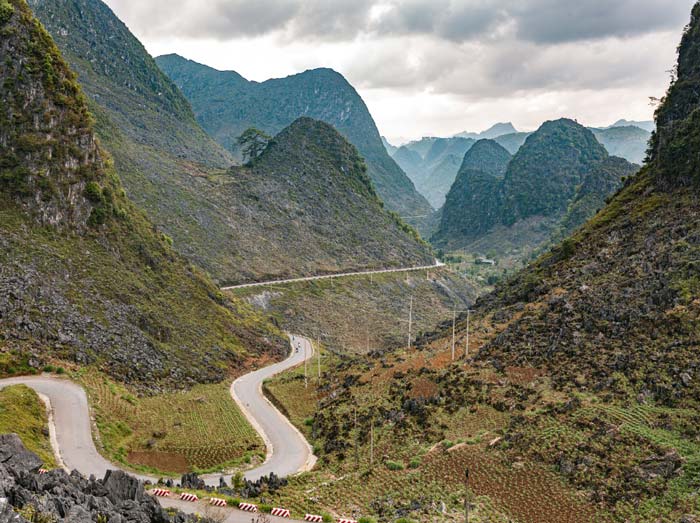
Even if you’re not into sports or prefer to avoid hiking, we still recommend spending a few days in Northern Vietnam to experience village life and meet ethnic minority communities. It’s a deeply enriching cultural immersion, especially if you’re traveling with children.
If you don’t have the time or inclination, you could instead visit the Ethnology Museum in Hanoi, which offers detailed insights into the customs and traditions of Vietnam’s 53 minority groups. In its gardens, you’ll even find reconstructions of traditional houses, bringing these cultures to life in an accessible way.
Hanoi
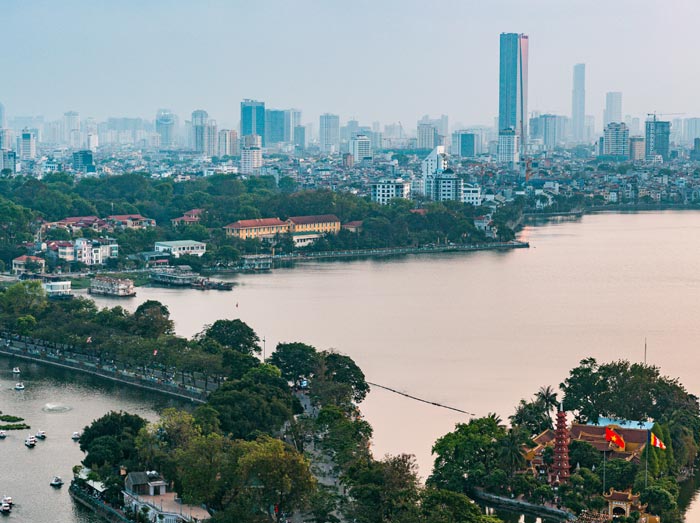
Hanoi is, of course, Vietnam’s cultural and historical capital. By visiting its monuments, you can retrace the country’s entire history: the influence of Confucian principles at the Temple of Literature, Vietnam’s imperial dynasties at the Thang Long Citadel, the colonial period with the Long Bien Bridge or the Opera House, and more.
You will also gain insight into Vietnamese beliefs and spiritual practices by visiting Tran Quoc Pagoda and several other temples scattered throughout the city. And no visit to Hanoi would be complete without exploring the Old Quarter, once the economic heart of the city and still a truly unique place in the world.
Hue
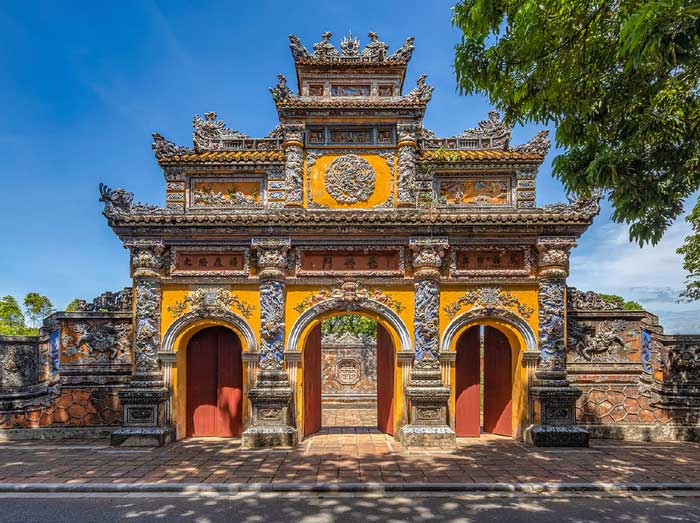
The city of Hue in Central Vietnam is another must-stop for anyone who wants to learn about the country’s history. It was here that the Nguyen dynasty built its Imperial City in the 19th century. Hue flourished, gaining a strong reputation as a center of art and intellect, until the arrival of French troops in the 1880s. The Imperial City was largely destroyed, and many valuable treasures such as furniture and manuscripts were stolen or burned. Later, the wars of independence—against both the French and the Americans—further devastated Hue’s cultural and historical heritage.
Fortunately, in recent years, major restoration efforts have taken place, and today it is once again possible to stroll through an Imperial City that has regained much of its former splendor. Beyond the Imperial City itself, visitors can explore many other important monuments, including the Emperors’ tombs, each of which requires several hours to visit.
Hoi An
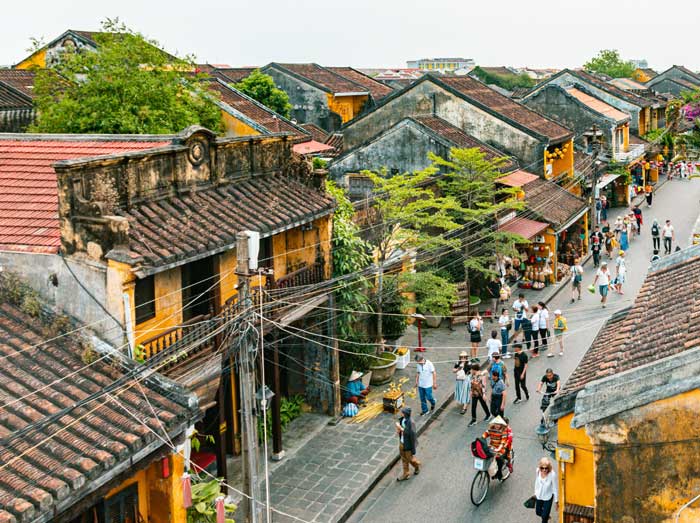
Although Hoi An is now primarily a tourist town, it was once an important port starting from the 15th century. Thanks to its strategic position, Hoi An was shaped by many cultural influences that are still visible in the architecture of its Old Town. Listed as a UNESCO World Heritage Site since 1999, the Old Town contains no fewer than 844 registered buildings of interest. Of course, you won’t have the time—or the patience—to visit them all!
Still, several remain absolute must-sees: the Japanese Covered Bridge, built in 1593 to link the city’s Japanese and Chinese quarters; Tan Ky House, the oldest in Hoi An and the first to be recognized as a Historical Monument in 1985; and the Phuc Kien Assembly Hall, once the gathering place of immigrants from China’s Fujian Province.
Ho Chi Minh City
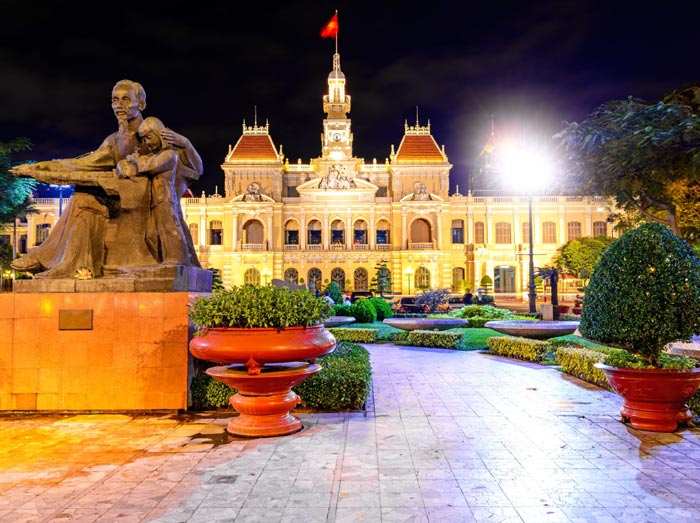
With ten million inhabitants, Ho Chi Minh City is Vietnam’s most populous metropolis and the country’s true economic leader. It is also a major historical and cultural destination.
Several centuries ago, the city was nothing more than a small fishing village belonging to the Khmer Empire. In the 17th century, it welcomed Vietnamese and Chinese settlers and became known as Saigon, named after the river that flows through it. Later, during the colonial period, Saigon was the city with the largest French presence. Renamed Ho Chi Minh City after the reunification of the country in 1975, it is today one of Asia’s most dynamic megacities.
Our guides will take you through its different neighborhoods—Vietnamese, Chinese, and French. Among the city’s must-see landmarks are: Saigon Notre Dame Cathedral, built in 1880; the Reunification Palace, built in 1868 and renovated in 1955; and Ben Thanh Market, dating back to 1860. And these are just a few of the many fascinating sites waiting to be explored.
Looking to plan a private, tailor-made journey?
Vietnam’s Main Historical Sites
In addition to these must-visit cities for a cultural stay in Vietnam, there are other historical sites that may capture your interest during your journey. We’ve listed below 10 sites that could be included in your tailor-made Vietnam itinerary.
Cham museum in Da Nang

The Champa Kingdom lasted for more than ten centuries, from the 5th to the 15th century, and it was only fitting that a museum be dedicated to honoring the memory of this great civilization. Da Nang was chosen as its home due to its proximity to the My Son Sanctuary.
Inside the museum, you will find no fewer than 300 artifacts, many of which showcase the remarkable artistry of Cham sculpture. From intricate sandstone statues of Hindu deities to architectural fragments of ancient towers, the collection offers a vivid glimpse into the sophistication and spiritual depth of Cham culture.
A visit to the Cham Museum not only complements an excursion to My Son but also provides essential context for understanding one of Southeast Asia’s most influential civilizations.
My Son sanctuary
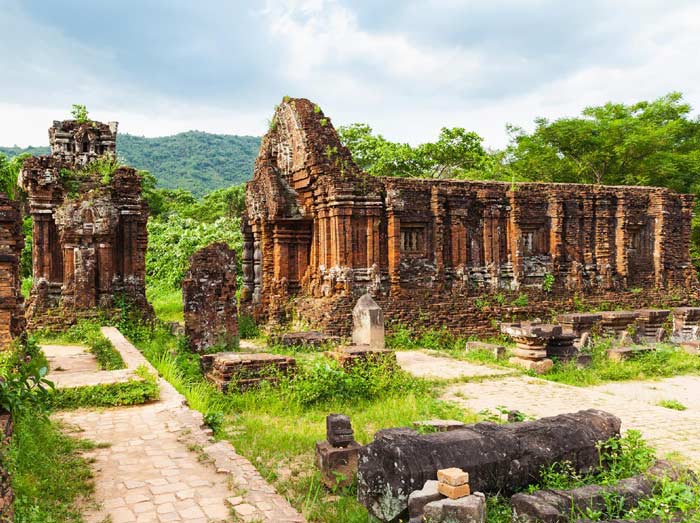
To extend your day dedicated to Cham civilization, you could visit the ruins of the My Son Sanctuary, located about 35 km west of Hoi An. My Son played a central role in the religious life of the Champa Kingdom, as successive kings enriched and embellished the site over more than ten centuries.
Although history has not spared the sanctuary—including the American bombing of 1969, which deliberately targeted its monuments—My Son remains a fascinating and essential place for anyone wishing to learn about the history of ancient civilizations.
Set in a lush valley surrounded by mountains, the complex of red-brick temples and towers is often referred to as the “Angkor of Vietnam.” Wandering through its ruins, you’ll witness both the spiritual grandeur of the Champa culture and the scars of time, making it one of Vietnam’s most evocative historical sites.
Temple of Literature

At the time when My Son’s influence was declining in the south of present-day Vietnam, Confucianism reigned supreme in the North. In the 11th century, Hanoi’s first university was built with the aim of teaching arts and moral philosophy to the sons of the royal family of the Ly dynasty. The creation of this institution marked the introduction of the mandarin system into Vietnam’s elite culture. Young men selected to study there became the high-ranking officials who served the Nation and the State. Upon graduation, they were honored with the title “Sons of the Nation” (Quoc Tu Giam).
In the 19th century, the university was transformed into a temple dedicated to Confucius. Several restorations were carried out with the support of the École Française d’Extrême-Orient, notably in 1920 and 1947. Further renovations followed after the wars in Indochina and Vietnam.
Today, the site remains a place of reverence: students still come to pray here or to celebrate their academic achievements, keeping alive a tradition that links Vietnam’s present to its thousand-year-old scholarly heritage.
Hoa Lu Ancient Capital
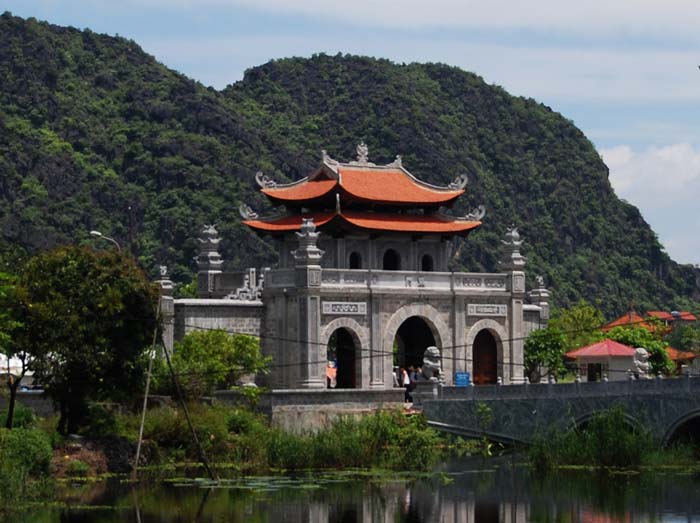
Hoa Lu was the first capital of Dai Co Viet, the “unified Vietnam,” between 968 and 1010. It was Emperor Dinh Tien Hoang who chose this site as the seat of his empire. Two other emperors, Le and Ly, later succeeded him before King Ly Thai To decided to transfer the Imperial City (Thang Long) to Hanoi.
Nevertheless, King Ly Thai To did not forget his predecessors and had numerous temples built in their honor in Hoa Lu. These temples are the main remains of the former capital that visitors can explore today.
Nestled among dramatic limestone peaks and lush greenery, Hoa Lu offers not only a journey into the country’s early history but also a stunning natural backdrop. Walking through its ancient temples and serene landscapes, you can almost feel the spirit of Vietnam’s first emperors and the birth of a nation.
Thang Long citadel
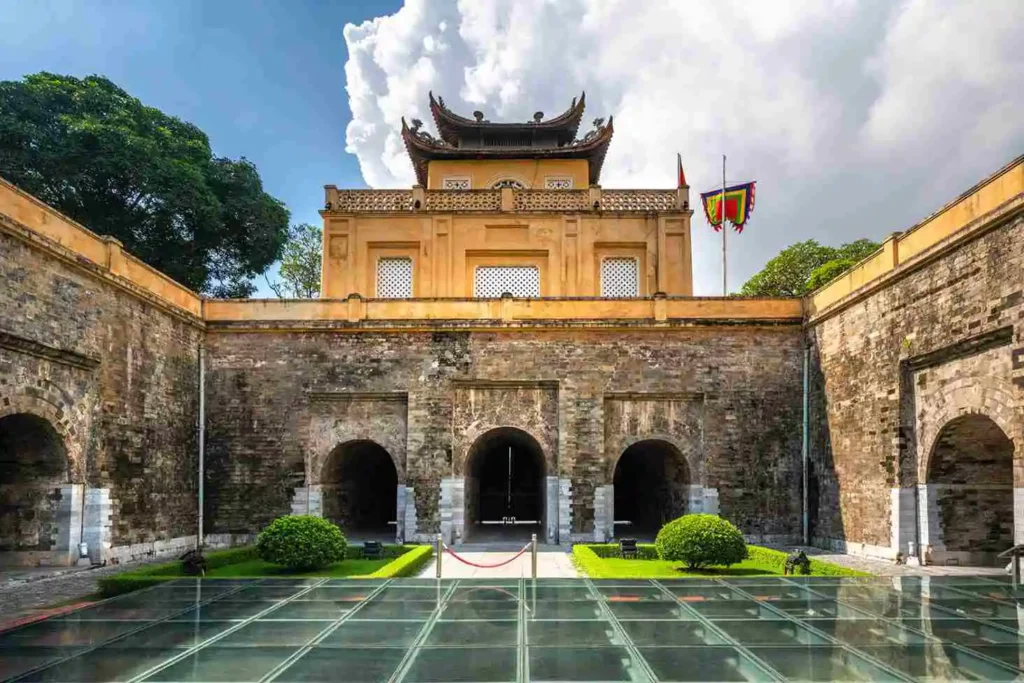
Among the other historical sites that bear witness to Hanoi’s thousand-year-old history is the Imperial Citadel of Thang Long. It was built by King Ly Thai To, who thereby founded the city of Hanoi. The first king of the Ly dynasty erected it on the remains of a former Chinese citadel, as a symbol of his triumph over the Chinese invaders he had just defeated.
A must-visit site if you want to understand the origins of Vietnamese civilization and its development over the centuries.
Hanoi Old Quarter
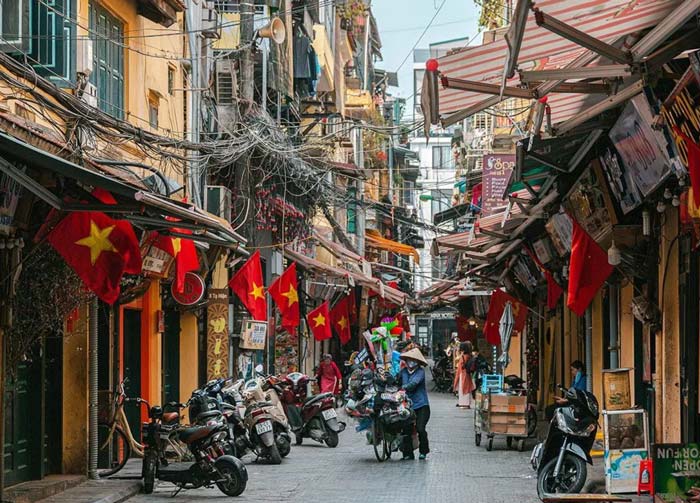
A few centuries later—during the 13th century—Hanoi began attracting craftsmen from surrounding regions, who soon organized themselves into cooperatives and guilds. From then on, villagers working in the same trade gathered together and operated on the same street, giving each street a distinctive and unified character that can still be seen today. This is how Hanoi’s “36 Guild Streets” were born.
The streets belonging to a guild were named “Hang” (meaning “merchandise”) followed by the product in which the guild specialized. Since that time, this district has remained the beating heart and economic center of the capital. Today, it is a must-see for all travelers. Beyond its cafés, bars, restaurants, and souvenir shops, you will also find numerous sites that tell the story of this historic neighborhood. One notable example is the “Ancient House at 87 Ma May Street,” a traditional 19th-century dwelling preserved in Hanoi’s Old Quarter.
Imperial City of Hue

As we have seen, the city of Hue is steeped in history, having served as the capital of the Nguyen Lords of the South in the 16th century, before becoming the capital of a unified Vietnam in the early 19th century under the reign of Gia Long. It was Gia Long who founded the famous Nguyen dynasty and built their Imperial City.
The dynasty flourished for more than a century, earning a strong reputation as a center of artistic and intellectual life, until the arrival of French troops in the 1880s. By visiting the Imperial City today, you are transported back to Vietnam before the French colonization.
Long Bien bridge
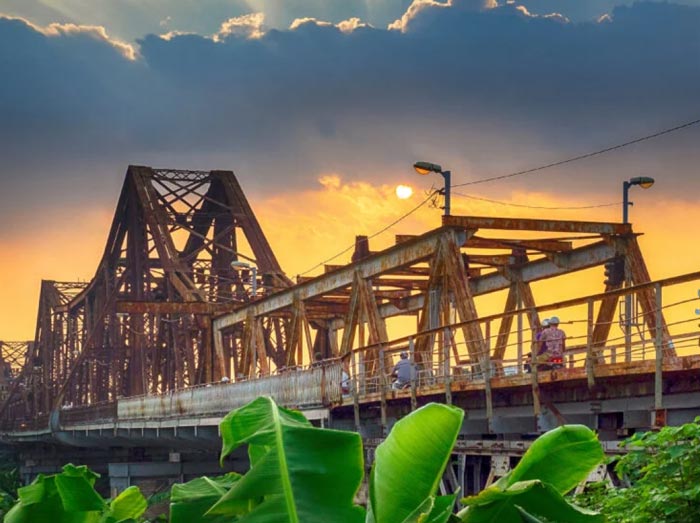
The French presence in Vietnam, which lasted nearly a century, left a strong imprint on the country’s landscape and architecture. Among the most significant landmarks is the Long Bien Bridge, which has become one of the symbols of the capital, Hanoi.
Originally called the “Paul Doumer Bridge,” after the then Governor-General of Indochina, it was inaugurated on February 28, 1903, after four years of construction. Contrary to popular belief, it was not designed by Gustave Eiffel but by the company Daydé & Pillé, which was later absorbed by the Eiffel Group in the second half of the 20th century. At the time, this was the first steel bridge to span the Red River, a striking symbol of French engineering expertise, and it ranked as the fourth longest bridge in the world.
Hoa Lo prison
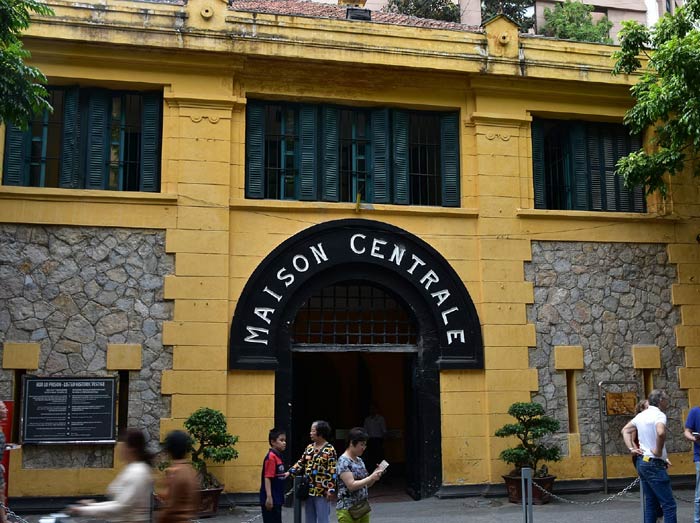
Among the many museums dedicated to the wars against the French and later the Americans, one of the most striking is the former Hoa Lo Prison in Hanoi. Today transformed into a museum, it recounts the suffering endured by Vietnamese revolutionaries during the French colonial period, with cells, relics, and testimonies bearing witness to the harsh conditions of detention.
What makes the site particularly fascinating is its later history: during the Vietnam War, the prison was used to hold American prisoners of war, who in turn were subjected to interrogations and mistreatment by the Viet Minh. This dual legacy makes Hoa Lo a place of memory that reveals both sides of Vietnam’s turbulent 20th-century history.
Cu Chi tunnels
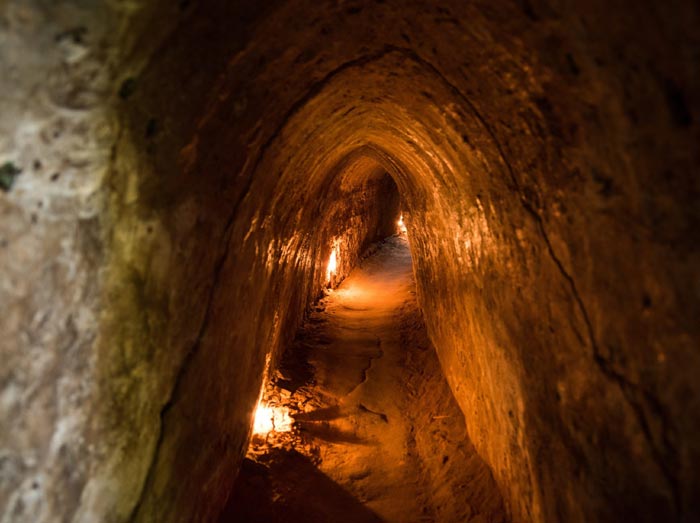
The Cu Chi Tunnels are a symbol of the ingenuity and resilience of the Vietnamese during their wars against both the French and the Americans. First created by the Viet Minh under French occupation, this tunnel system was later expanded during the conflict with the Americans, eventually stretching to more than 250 kilometers.
At the height of the war, over 15,000 people sheltered within the tunnels, which also served as a key endpoint of the Ho Chi Minh Trail.

